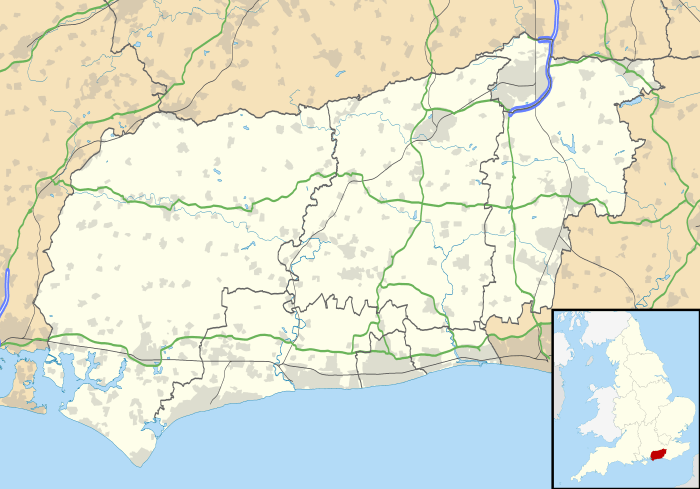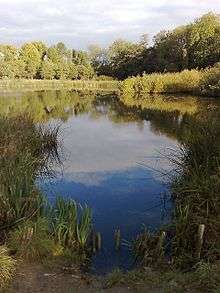Ifield, West Sussex
| Ifield | |
|---|---|
 Ifield Ifield shown within West Sussex | |
| Population | 8,882 (Ward. 2011 Census)[1] |
| OS grid reference | TQ255375 |
| District | |
| Shire county | |
| Region | |
| Country | England |
| Sovereign state | United Kingdom |
| Post town | Crawley |
| Postcode district | RH11 |
| Dialling code | 01293 |
| Police | Sussex |
| Fire | West Sussex |
| Ambulance | South East Coast |
| EU Parliament | South East England |
| UK Parliament | |
Ifield is a former village and now a neighbourhood within the town of Crawley in West Sussex, England. Ifield is in the west of the town and is bordered by Ifield West, Horsham, Langley Green to the north east, West Green to the east across the ring road and Gossops Green and Bewbush to the south across the Arun Valley railway line.
Education
There are five schools in Ifield neighbourhood:
- Primary Schools: St.Margaret's Church of England Primary School and Mill Primary Academy
- Secondary School: Ifield Community College
- Special Schools: Manor Green School and Manor Green College
Ifield station
Ifield station is located on the south side of the neighbourhood on the border with Gossops Green neighbourhood. The station is part of the Arun Valley Line and was opened in 1907 as 'Ifield Halt'. Services run to Three Bridges Station and London Victoria on Platform 1 and Horsham on Platform 2. The level crossing that used to be in operation was replaced by the footbridge that now connects the two platforms.
Ifield Water Mill and Mill Pond

Ifield Mill Pond lies between Bewbush, Gossops Green and Ifield West. It is the source of the River Mole which runs north to the River Thames above Teddington Lock. In 1683[2] Ifield Water Mill, a corn mill, was built in the north of the pond; it used water from the mill pond to turn its water wheel. It was rebuilt in 1817 and is now being restored.[3] The restoration has been led by a team of volunteers and spearheaded by Ted Henbery MBE, who has spent 34 years on the project after his son discovered the disused site in 1974.[4] A second project to upgrade the Mill Pond concluded in July 2015 after £6.5 million was spent upgrading the dam, finished £1 million under budget.[5] The Mill Pond is considered to be "the most important wetland site in Crawley"[6] and supports a rich bird community:
- Birds that breed in the Mill Pond:
- Birds that visit the Mill Pond in the winter:
History
The name Ifield is derived from "Yew-field". There were many Yew trees in the parish, and some can be seen in the churchyard of St Margaret's Church. Ifield contains some of the most historic parts of Crawley, and there is a mention in the Domesday Book: "it is and was worth 20 shillings", where Ifield was spelt Ifelt.[7] Locally there is much evidence of Saxon iron works and a stretch of Roman Road still exists today known locally as the "Quarter Mile".[8] St Margaret's Church was built in the 13th century. It contains both the grave of Mark Lemon (the first editor of Punch), and the Holles family vault. Adjacent to St Margaret's Church is the Ifield Barn Theatre. The old parish of Ifield contained most of the western part of modern-day Crawley, and the old village is on the very western edge of the new town. As well as containing two modern churches - St.Leonards in Langley Green and St.Albans in Gossops Green - Ifield Parish also contains a Friends' Meeting House. Founded in 1676 it was the first purpose-built meeting place for the Quakers anywhere in the world.[8] A V-1 flying bomb landed in Ifield during World War II. It damaged the village school and wounded one local man who remained slightly brain damaged for the rest of his life.
Denzil Holles was created Baron Holles of Ifield in 1661, after his part in the restoration of Charles II of England. The peerage became extinct after his grandson died unmarried and without issue. Denzil was buried in Westminster Abbey, but his family are interred here.
Ifield Barn Theatre
The theatre is situated on the outskirts of Crawley and overlooks a pond and unspoilt fields. It lies immediately, to the north of the 13th century church of St Margaret, in the manor of Ifield which was originally recorded in the Doomsday Book. The Barn Theatre together with the church, a village pub and some picturesque cottages now forms a designated conservation area.
The theatre buildings were created from a group of agricultural buildings and consist of a tithe barn which now forms the auditorium with dressing rooms in its outbuildings, a former Granary which serves as a kitchen, and stables which have been converted to an exhibition room and workshops. All three buildings have been linked by a modern addition tastefully integrated to form the foyer and theatre bar. Due to some inspired fund-raising by members many improvements have been made to the theatre.
The Ifield Barn Theatre Society was founded in 1968. Throughout its life, it has been maintained by voluntary donations and is managed entirely by the unpaid efforts of its members.
References
- ↑ "Ward population 2011". Neighbourhood Statistics. Office for National Statistics. Retrieved 30 September 2016.
- ↑ Bracher, P. (1994). Ifield Water Mill: its Owners and Occupiers. Publication Number 3. Crawley: Crawley Museum Society. p. 8.
- ↑ "Sussex Windmills and Watermills Open to View". Sussex Mills Group website. Sussex Mills Group. 2009. Retrieved 2009-02-02.
- ↑ "History Profile - Ifield Mill - Crawley TV". Crawley TV. Retrieved 2015-08-05.
- ↑ "PHOTOS: Ifield Mill Pond reopened after £6.5 million of work". Retrieved 2015-08-05.
- ↑ "Ifield Mill Pond". Crawley Borough Council website. Crawley Borough Council. 2008. Archived from the original on 2007-09-28. Retrieved 2009-02-02.
- ↑ domesdaybookonline.co.uk
- 1 2 british-history.ac.uk
External links
| Wikimedia Commons has media related to Ifield, West Sussex. |